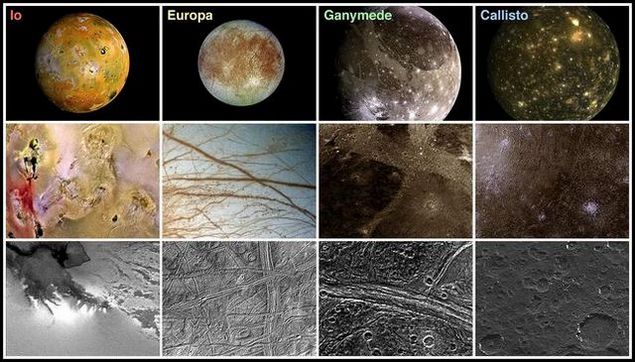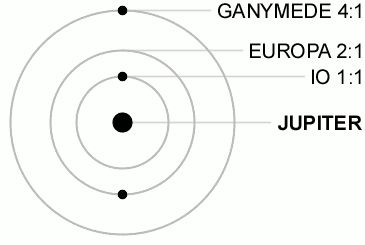The Galilean moons are the four largest moons of Jupiter Io, Europa, Ganymede, and Callisto. They were discovered by Galileo Galilei around January 1610 and were the first group of objects found to orbit another planet. Their names derive from the lovers of Zeus. They are among the most massive objects in the Solar System with the exception of the Sun and the eight planets, with radii larger than any of the dwarf planets. Ganymede is the largest moon in the Solar System, and is even bigger than the planet Mercury.

The three inner moons Io, Europa, and Ganymede are in a 4:2:1 orbital resonance with each other. Fluctuations in the orbits of the moons indicate that their mean density decreases with distance from Jupiter. Callisto, the outermost and least dense of the four, has a density intermediate between ice and rock whereas Io, the innermost and densest moon, has a density intermediate between rock and iron.

Callisto has an ancient, heavily-cratered and unaltered ice surface and the way it rotates indicates that its density is equally distributed, suggesting that it has no rocky or metallic core but consists of a homogeneous mix of rock and ice.
Fof more info please visit the wikipedia.org
Europa
is the sixth-closest moon of Jupiter, and the smallest of its four Galilean satellites, but still the sixth-largest moon in the Solar System. Europa was discovered in 1610 by Galileo Galilei and was named after Europa, mother of king Minos of Crete, who became one of Zeus' lovers. Progressively better observations of Europa have occurred over the centuries by Earth-bound telescopes, and by space probe flybys starting in the 1970s.
Slightly smaller than the Moon, Europa is primarily made of silicate rock and has a water-ice crust and probably an iron–nickel core. It has a tenuous atmosphere composed primarily of oxygen. Its surface is striated by cracks and streaks, whereas craters are relatively rare. It has the smoothest surface of any known solid object in the Solar System.The apparent youth and smoothness of the surface have led to the hypothesis that a water ocean exists beneath it, which could conceivably serve as an abode for extraterrestrial life

This hypothesis proposes that heat from tidal flexing causes the ocean to remain liquid and drives geological activity similar to plate tectonics. On 8 September 2014, NASA reported finding evidence supporting earlier suggestions of plate tectonics in Europa's thick ice shell—the first sign of such geological activity on a world other than Earth. On 12 May 2015, scientists announced that sea salt from a subsurface ocean may be coating some geological features on Europa, suggesting that the ocean is interacting with the seafloor. This may be important in determining if Europa could be habitable for life.
Europa : detailed specification and data
SAFETY WARNINGS
Terrain specified in the header corresponds to the real situation in terrain of the cache placement. Please consider your options, capabilities weather conditions. Remember that the safety is in first place in all circumstances. All you are doing is on your own risk, the author assumes no responsibility. Please protect the nature.
BEZPEČNOSTNÍ UPOZORNĚNÍ
Terén uvedený v záhlaví odpovídá skutečnému uložení krabičky a proto prosím zvažte vaše možnosti, schopnosti, povětrnostní podmínky. Pamatujte že bezpečnost je až na prvním místě. Kešku lovíte na vlastní nebezpečí, autor nenese žádnou odpovědnost. K přírodě se chovejte ohleduplně a neničte ji.